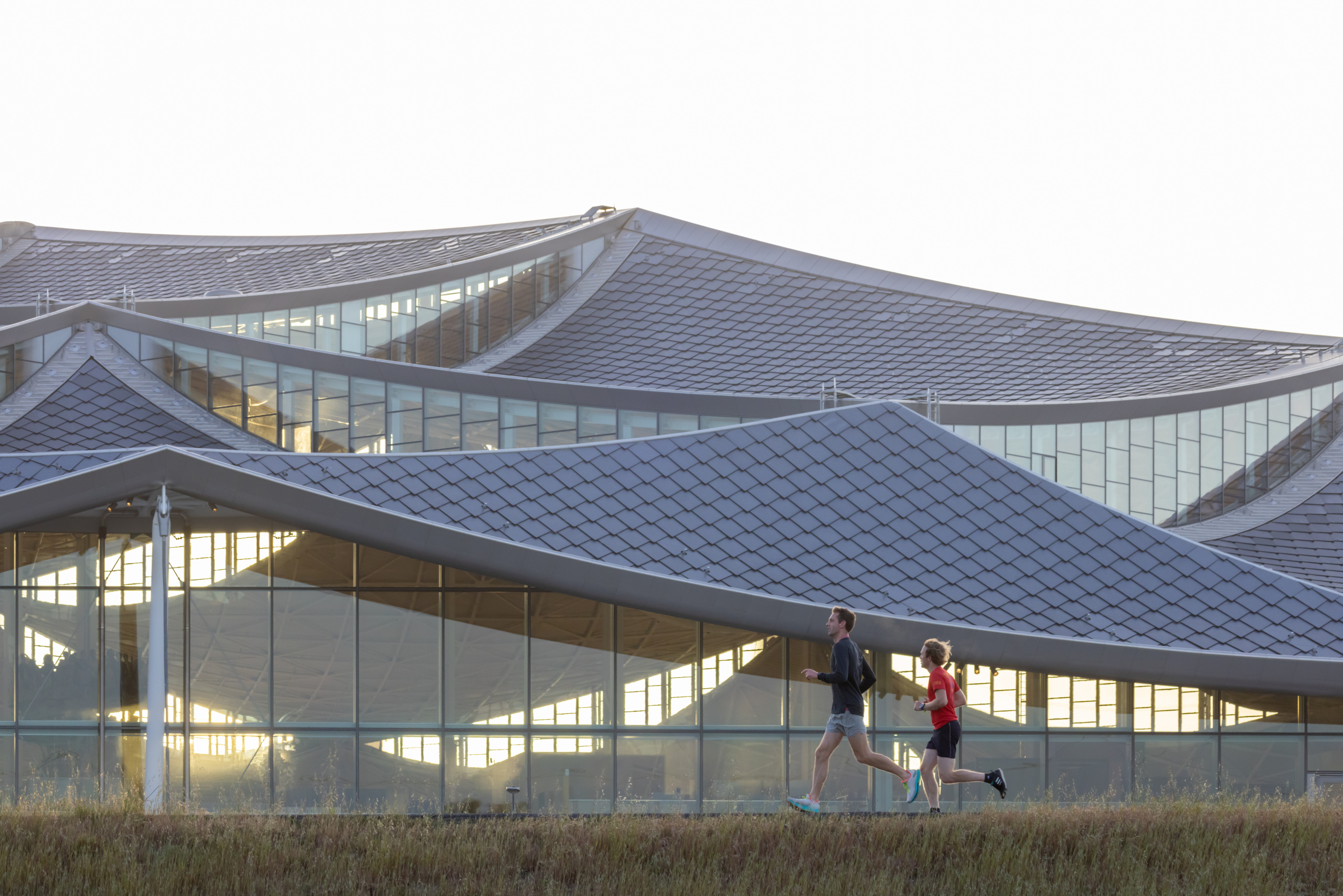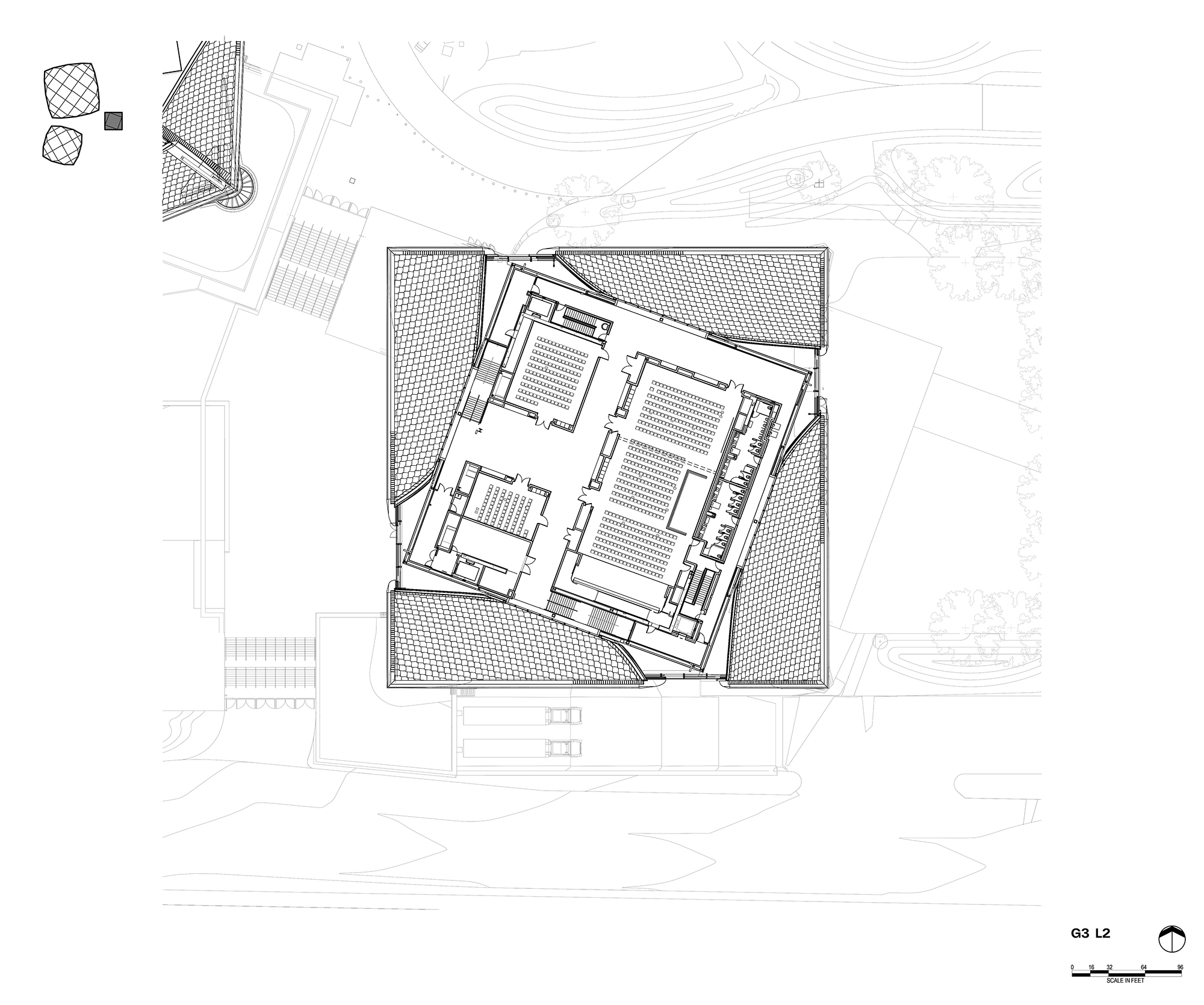

建筑设计 BIG建筑事务所+赫斯维克工作室
项目地点 美国加州
建成时间 2022年
项目规模 102193平方米
在与谷歌的紧密合作下,由BIG建筑事务所与赫斯维克工作室合作设计的湾景园区(Bay View)现已正式开放。这是谷歌首个从零起步的园区,旨在于2030年之前实现全天候的“零碳”运作。这座全新的总部也是谷歌宏伟愿景的体现,即为未来的谷歌工作场所提供以人为本的可持续创新设计,以及为建筑及其他行业提供可参考、可复制的解决方案。
Designed by BIG-Bjarke Ingels Group and Heatherwick Studios in close collaboration with Google, Bay View is Google’s first-ever ground-up campus with the mission to operate on carbon-free energy, 24 hours a day, seven days a week by 2030. The buildings deliver on Google’s ambition to create human-centric, sustainable innovations for the future of Google’s workplace as well as scalable, replicable solutions for the construction industry and beyond.

湾景园区临近硅谷NASA艾姆斯研究中心,占地42英亩(约17万平方米)。园区由三座建筑组成,总建筑面积110万平方英尺(约10.2万平方米),其中包括20英亩的开放空间、两座办公建筑、一个可容纳1000人的活动中心,以及240套短期员工住宿单元。三座建筑均采用了轻质的天棚结构,并在内部采光、视景、协作办公、体验与活动方面进行了优化。
Located on a 42-acre site at the NASA Ames Research Center in Silicon Valley, the Google Bay View Campus, consisting of three buildings, totals 1.1 million sq ft – including 20 acres of open space, two workspace buildings, a 1,000-person event center, and 240 short-term employee accommodation units. All three buildings are constructed as lightweight canopy structures optimized for interior daylight, views, collaboration, experiences and activities.

园区的三座新建筑也是谷歌宏伟愿景的重要组成,助力谷歌在2030年前成为首家全天候实现零碳能源运作的大公司。园区预计将取得LEED-NC v4铂金级认证,还将成为获得国际未来生活研究院(ILFI)生命建筑挑战(LBC)水花瓣认证的最大建筑。
Bay View’s three new buildings are part of Google’s ambition to be the first major company to operate on carbon-free energy, 24 hours a day, seven days a week by 2030. The site is expected to achieve a LEED-NC v4 Platinum certification and become the largest facility ever to attain the International Living Future Institute (ILFI) Living Building Challenge (LBC) Water Petal Certification.

项目初始,谷歌就在设计任务书中确定了三个主题——创新、自然、社区。此次设计以充满灵活性的非凡用户体验为驱动,激发使用者们的协作与共同创造。团队空间位于上层,而聚会空间位于下层,将重点区域与协作区域分开,同时为两者均提供便捷的交通。二层有着多变的楼板设计,为团队提供了一处指定的“邻里”空间,该区域有着高度的灵活性,可以随着使用需求的变化而改变。
Anchored in three themes defined by Google’s design brief at the beginning of the project – innovation, nature, and community – the design is driven by flexibility and extraordinary user experience that inspires collaboration and co-creation. Team spaces are on the upper level and gathering spaces are below, separating focus and collaborative areas while still providing easy access to both. The second floor design has variation in floorplates to give teams a designated “neighborhood” area that is highly flexible to change with their needs.

BIG建筑事务所创始人兼创意总监,比亚克·英格斯表示:“新园区的设计,是次难以置信的合作经历。与谷歌这样以数据为导向的业主合作,让我们在建筑中的每次决定,都有可靠的信息与经验分析来支撑。在园区中,引人瞩目的龙鳞状太阳能屋面,将直射建筑的每束光能都储存下来;能源堆可以储存和调用地热能,对建筑的冷热进行调节;甚至连自然、美丽的植物群实际上都是勤劳的‘根部花园’,可以过滤和清洁建筑中的废水。”
“Our design of the new Bay View campus is the result of an incredibly collaborative design process. Working with a client as data driven as Google has led to an architecture where every single decision is informed by hard information and empirical analysis. The result is a campus where the striking dragonscale solar canopies harvest every photon that hits the buildings; the energy piles store and extract heating and cooling from the ground, and even the naturally beautiful floras are in fact hardworking rootzone gardens that filter and clean the water from the buildings.
“总而言之,园区中空间的内与外、技术与建筑、形式与功能,已经融合成一个引人注目的全新综合体。”
All in all, a campus where front of house and back of house, technology and architecture, and form and function have been fused into a new and striking hybrid,” says Bjarke Ingels, Founder and Creative Director, BIG-Bjarke Ingels Group.

湾景大楼仅有两层,上层是办公与团队协作空间,下层则提供了各种便利设施。贯穿楼内的一系列室内庭院将上下两层串联,让团队能便捷地抵达咖啡吧、厨房、会议室与全体员工的办公空间。在不同楼层和工作模式间循环时,庭院既是促进运动的健康好地,也可以辅助寻路指引。
The Bay View Buildings are split across only two floors, with desks and team spaces on the upper level, and the amenity spaces below. A series of indoor “courtyards” throughout the buildings connect the two levels, giving teams easy access to cafes, kitchenettes, conference rooms, and all-hands spaces. The courtyards also encourage the physiological benefits of physical movement when circulating between levels and different modes of work, and double as wayfinding devices.


在上部,由均分正交柱网支撑的大跨度天棚,允许整个二层空间在一个屋面下实现开放互联,这些工作空间优先考虑自然采光与景观,通过精心设计的天窗来减少眩光。
Above, the large-span canopy with average orthogonal column spans allows the entire second-level workspaces to be open and connected under one roof. These workspaces prioritize access to natural light and views, with reduced glare through carefully designed clerestory windows punctuating the canopy.



天幕屋顶也体现出结构的创新,不用过多的柱子与剪力墙去分割,转而换取一个宽阔的工作空间。每个人都能平等地获得整个楼面的视景,并通过周边的外立面与天窗去欣赏户外的景色。在外部,这三座建筑都拥有首创的“龙鳞”太阳能屋面设计,共配有5万块银色太阳能电池板,共计可产生近7兆瓦的电量。
Rather than being segmented by excessive columns and support walls, the structural innovation of the canopy roof allows for a wide-open workspace; every person has equal access to views across the floorplate, and through the perimeter facade and clerestory windows to the outdoors. On the exterior, all three buildings feature a first-of-its-kind “dragonscale” solar skin roof equipped with 50,000 silver solar panels that generate a total of nearly seven megawatts of energy.

这个在所有建筑上应用的天棚设计,是多年努力而来的结果,以实现最实用、最节能和最经济的建筑解决方案:一个由管状钢制成的网状系统,在天棚托架与不透明的屋顶结构间置入有简单的天窗。这一设计可提供最佳的声学控制效果,最小化热增益,降低建筑总体的能源负荷,并于外部收集最多的太阳能。内部的工作空间借此得到充足的日光,却不必担忧过多的眩光困扰。建筑中的每个工位都能欣赏外部的景致,在一天的大部分时间中都能得到阳光。
This canopy superstructure applied across all the buildings is the result of a multi-year effort to achieve the most functional, energy-efficient, and economical building solution: a net system made of tubular steel with simple clerestory windows between the canopy bays and an opaque roof structure offers the best acoustic control, minimizes thermal heat gain, lower overall energy loads, and allows Google to harvest the maximum amount of solar PV on the outside. It also provides daylight to the workspaces inside without excessive glare, allowing every desk in the building to have views of the outside, and access to daylight throughout most of the day.

BIG建筑事务所合伙人Leon Rost也表示,湾景园区提供了一种与城市高层建筑截然相反的工作场所体验,它的面积等同于旧金山最高的办公大楼,通常竖向堆叠的楼板在这里被重新分配成一个平面上的阵列,创作出一个充满活力的“村庄”。在摩天大楼中,碳中和与水中和是个设计中的挑战,但在这种海湾建筑能使设计师利用太阳、地球与水的力量。希望湾景园区能为工作场所的发展提供一个质的飞跃,提升可持续设计的基准,并激发下一代使用者与访客对建筑的兴趣。
“Google Bay View offers a workplace experience that is an antithesis to an urban high-rise; Containing as much area as the tallest office tower in San Francisco, the typically stacked floorplates are redistributed into a flat array, creating a vibrant village. While on-site carbon and water neutrality is challenging for skyscrapers, this bay-scraper typology enables us to harvest the power of the sun, earth, and water. We hope Bay View will provide a quantum leap in the evolution of the workplace, elevate the benchmark for sustainable design, and inspire the next generations of users and visitors to the building,” says Leon Rost, Partner, BIG-Bjarke Ingels Group.

园区完全依靠电能运作,有着北美地区最大的地热堆系统,预计可以减少50%的碳排放和90%的冷却用水。此外,由谷歌构建的现场系统可收集、处理与再利用所有雨水和废水,支持栖息地恢复与海平面上升保护,并为谷歌员工及公众提供了在周边海湾小径上欣赏自然湿地美景的契机。
Bay View operates entirely on electric energy and the campus houses the largest geothermal pile system in North America, estimated to reduce carbon emissions by almost 50% and water used for cooling by 90%. In addition, on-site systems built by Google collect, treat, and reuse all stormwater and wastewater and provide habitat restoration, sea level rise protection, and access to the beauty of natural wetlands for both Googlers and the public on the nearby Bay Trail.

谷歌希望为整个行业带来进步,因此在湾景园区的设计中,也产生了几种可扩展的解决方案:增加模块化建设、规模前所未有的地热、光伏设计的创新、黑水处理系统的支持、从垃圾填埋场转移出来的废物、改进红名单成分审查的产品总数,以及旨在促进水资源管理,并为受到威胁的野生动物提供宝贵栖息地的景观设计。
Google’s mission to unlock advancements for the benefit of the entire industry have led to several scalable solutions in working on the Bay View campus: increasing modular construction, geothermal at new scales, innovation in PV design, a permitted blackwater system, waste diverted from landfill, improved total number of products vetted for Red List ingredients, and landscape designed to advance water stewardship and create valuable habitat for threatened wildlife.
总而言之,谷歌湾景园区提供了一种全新的构架、材料语言和生态方法,将有助于推动工作场所及整个建筑环境的发展。
Overall, the Google Bay View campus has forged a new framework, materials language, and ecological approach that will help push both the future of the workplace, and the built environment-at-large, forward.

设计图纸 ▽







完整项目信息
Name: GOOGLE BAY VIEW
Program: Commercial
Status: Completed
Size in m2: 102193
Project type: New Build
Client: Google
Collaborators: BIG-Bjarke Ingels Group (Design Architect), Heatherwick Studio (Design Architect), Sares Regis (Development Group), Adamson (Executive Architect), STUDIOS (Interior Architect), Populous (Events Consultant), Thornton Tomasetti (Structural Engineers), Integral Group (Mechanical, Plumbing & Fire Protection Engineer), Olin (Landscape Architect), ARUP (Acoustic Consultant & Facade Engineers), BKF (Civil Engineer), Sherwood (Water Engineer), Holmes (Fire & Life Safety), Kleinfelder (Geotechnical Engineer), Loisos + Ubbelohde (Daylighting Consultant), FMS (Lighting Consultant), C.S. Caulkins Co (Access & Maintenance), Teecom (Telecommunications), Whiting-Turner (General Contractor), Applied Wayfinding (Signage & Wayfinding)
Location Text: Mountain View, California
Location: (37.3860517,-122.0838511)
PROJECT TEAM
Partner-in-charge: Bjarke Ingels, Beat Schenk, Daniel Sundlin, Leon Rost, Thomas Christoffersen
Project Leaders: Blake Smith, Ryan Harvey, David Iseri, Florencia Kratsman
Project Managers: Linus Saavedra, Ziad Shehab
Team: Agla Egilsdottir, Alessandra Peracin, Ali Chen, Andriani Atmadja, Alvaro Velosa, Armen Menendian, Benjamin Caldwell, Benson Chien, Bernard Peng, Brian Zhang, Camilo Aspeny, Cheyne Owens, Christopher Wilson, Claire Thomas, Cristian Lera, Cristina Medina-Gonzalez, Danielle Kemble, David Spittler, Deborah Campbell, Derek Wong, Diandian Li, Dylan Hames, Erik Kreider, Eva Maria Mikkelsen, Guillaume Evain, Hacken Li, Helen Chen, Isabella Marcotulli, Isela Liu, Jason Wu, Jennifer Dudgeon, Jennifer Kimura, Jennifer Wood, Jeremy Siegel, Jia Chengzhen, Ji-Young Yoon, Jian Yong Khoo, John Hilmes, Jonathan Fournier, Joshua Plourde, Julien Beauchamp-Roy, Kalina Pilat, Kiley Feickert, Kurt Nieminen, Lina Bondarenko, Mads Kjaer, Manon Otto, Marcus Kujala, Maria Acosta, Meghan Bean, Michelle Stromsta, Nandi Lu, Nicole Passarella, Olga Khuraskina, Oliver Colman, Otilia Pupezeanu, Patrick Hyland, Peter Kwak, Ramona Montecillo, Rita Sio, Sebastian Claussnitzer, Sebastian Grogaard, Seo Young Shin, Shu Zhao, Siva Sepehry Nejad, Terrence Chew, Thomas McMurtrie, Tiago Sa, Timothy Cheng, Tingting Lyu, Valentino Vitacca, Vincenzo Polsinelli, Walid Bhatt, Yesul Cho, Yina Moore
版权声明:本文由BIG建筑事务所授权发布。欢迎转发,禁止以有方编辑版本转载。
投稿邮箱:media@archiposition.com
上一篇:隐于山水:斯途·凤凰屿民宿改造 / 之行建筑事务所+永信和瑞工程咨询
下一篇:Barozzi Veiga如何做设计? | 有方讲座67场实录